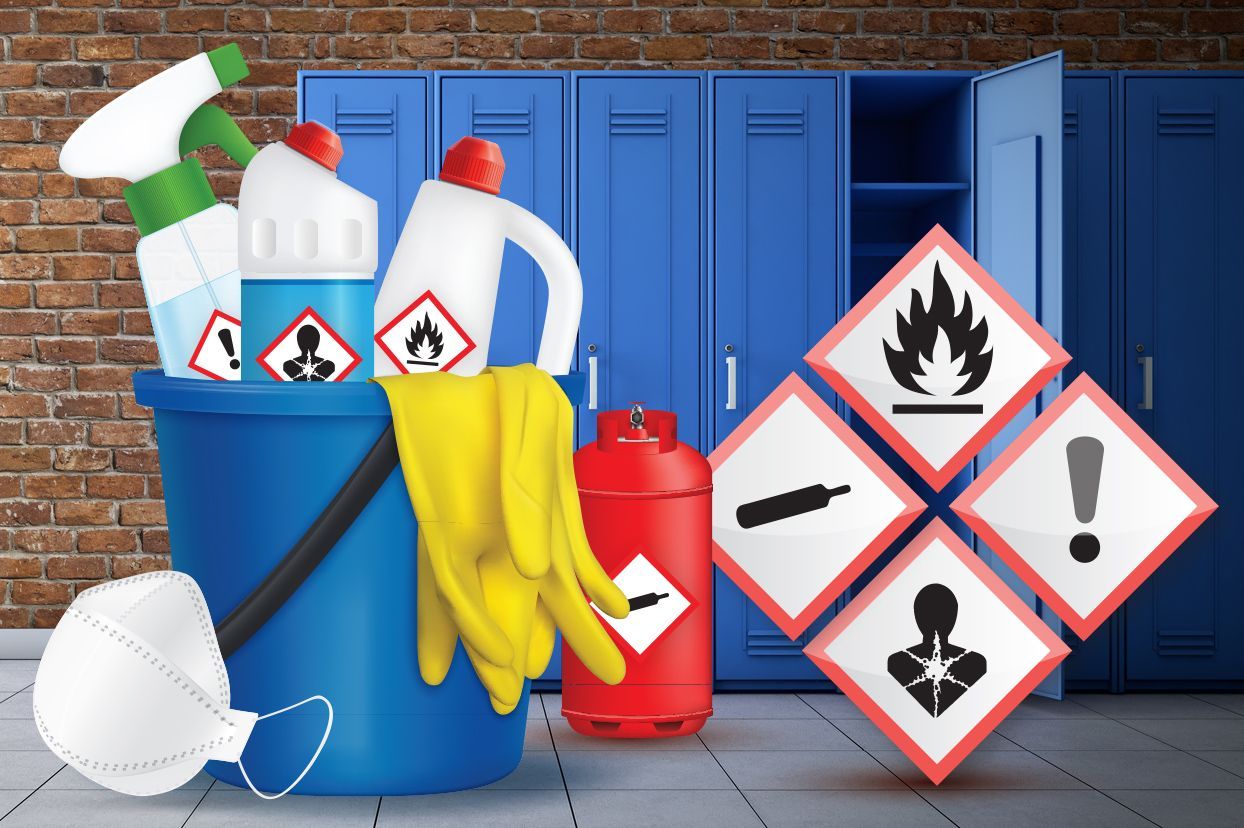Hazardous Chemicals in the Workplace
Hazardous Chemicals in the Workplace

Hazardous Chemicals in the Workplace
There are literally thousands of hazardous chemicals used in the workplace – paints, pesticides, cleaners and fuels, to name a few. They come in various forms including powders, solids, liquids and gases.
There have been many injuries in workplaces as a result of poor handling or storage of hazardous chemicals. Hazardous chemicals that you use at work can cause cancer, respiratory illnesses, skin and eye irritations, and fire and explosion-related injuries.
Therefore, it is critical we manage the health and safety risks associated with hazardous chemicals used in their workplace and we all have a duty to take reasonable care for our own health and safety and others at the workplace.
Globally Harmonized System of Classification and Labelling of Chemicals (GHS).
Under the WHS Regulations, a hazardous chemical is any substance, mixture or article that satisfies the criteria of one or more hazard classes in the Globally Harmonized System of Classification and Labelling of Chemicals (GHS).
We use the GHS classifications in Australia to communicate chemicals’ properties and dangers through labels, registers and safety data sheets.
There are two broad types of hazards associated with hazardous chemicals which may present an immediate or long-term injury or illness to people. These are Health Hazards and Physical Hazards.
Safety Data Sheets
Under the GHS, a Safety Data Sheet (SDS), which was previously called a Material Safety Data Sheet (MSDS) now includes requirements and minimum standard for the formatting and content of Safety Data Sheets used for communicating a chemical’s hazard through Safety Data Sheets (SDS).
Safety Data Sheets must contain information on the properties of hazardous chemicals and how they affect health and safety and includes generally information on:
- the identity of the chemical,
- health and physicochemical hazards,
- safe handling and storage procedures,
- emergency procedures, and
- disposal considerations.
The minimum standard for the formatting and content of Safety Data Sheets now includes a 16 Section format which includes certain types of information in each section. This standard format better ensures that all employers and employees understand the chemical, its hazards and the precautions users must take to remain safe.
Safety Data Sheets in your workplace must be reviewed periodically and kept up to date. This includes when any new or significant information becomes available on the hazards of the material, and they must be reviewed and re-issued every 5 years.
There are still come countries that do not use the same criteria for classification of hazardous chemicals. Some overseas Safety Data Sheets may not meet Australian requirements, and the importer of a chemical is responsible for ensuring the Safety Data Sheet for the imported chemical meets the Australian requirements.
Register of Hazardous Chemicals
It is a requirement that a Register of Hazardous Chemicals is prepared and kept up to date at the workplace. The Register of Hazardous Chemicals must be readily accessible to workers and to anyone else who is likely to be affected by a hazardous chemical at the workplace.
The Register of Hazardous Chemicals shall contain a list of the product names of all hazardous chemicals used, and accompanied by the current Safety Data Sheet for each hazardous chemical listed and must be updated as new hazardous chemicals are introduced to the workplace.
Manifest
A manifest is different from a register. A manifest is a written summary of specific types of hazardous chemicals with physical hazards, acute toxicity or skin corrosion that are used, handled or stored at a workplace. A manifest is only required where the quantities of those hazardous chemicals exceed prescribed threshold amounts contained within the WHS Regulations.
A Manifest contains more detailed information than a register of hazardous chemicals as its primary purpose is to provide the emergency services organisations with information on the quantity, classification and location of hazardous chemicals at the workplace. It also contains information such as site plans and emergency contact details.
Zenergy eLearning - Hazardous Chemicals in the Workplace
This online course introduces you to requirements and obligations regarding Hazardous Chemicals in the workplace which can pose considerable danger to workers and is essential for anyone exposed to Hazardous Chemicals as part of their employment.
The aim of this online course is to give you an understanding of the hazards and risks of Hazardous Chemicals in the workplace, key requirements of the Globally Harmonized System of Classification and Labelling of Chemicals (GHS), general safety precautions and requirements for Safety Data Sheet (SDS), Supplier and Workplace Labels, Safe Use, Storage, and Disposal of Hazardous Chemicals, Register of Hazardous Chemicals, Manifests, Personal Protective Equipment. This course outlines the requirements and obligations for emergency equipment and emergency procedures.
Click on the following link to review further course details: Hazardous Chemicals in the Workplace
Hazardous Chemicals In Your Workplace- Contact Us to Discuss Your Needs
If you would like additional information on how Zenergy can help deliver and managing the health and safety risks associated with hazardous chemicals used in their workplace, from Hazardous Chemicals Risk Assessment, preparation of a Register of Hazardous Chemicals and Manifests contact us today for further information and discussion.
As industry partners to organisations around Australia we have proven experience in delivering fit for purpose practical solutions and professional services across a multitude of industries and sectors for safety risks associated with hazardous chemicals meet your needs. Through a combination of our experience, academic achievements and business experience we add value to our client's business needs.
For further information please contact us on - info@zenergygroup.com.au or 1300 333 400






